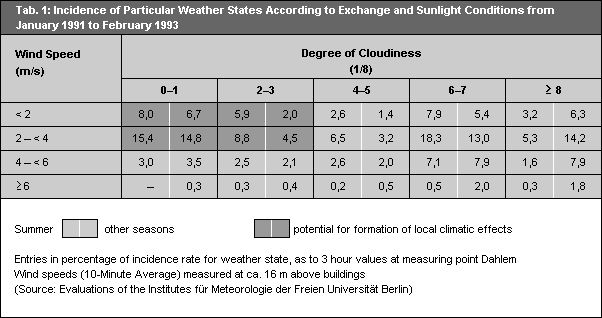Basically, a two-peak distribution can be found for each season. One peak represents weather conditions with slight wind speeds and relatively heavy cloudiness; the other represents weather conditions with slight wind speeds and high radiation intensity, which are a problem both in terms of climate and of air purity. During the winter months, these weather conditions tend toward low-exchange situations with high pollutant content in the atmosphere. In the summer, they are caused chiefly by stationary high-pressure areas, in the course of which considerable bioclimatic stress potential can develop locally. In the summers under investigation, these weather conditions appeared in more than 38% of all observed cases.
Especially in view of these spatially caused problem weather conditions, climatically favorable structures and structures which provide relief are of great significance. These include on the one hand extensive open spaces near the periphery of cities with offshoots extending, in some cases, as far as the city center. Determinant for their degree of efficacy are the terrain-relief situation, vegetational structures and the density of development in the transition areas between the city center and the surrounding countryside. Even slightly sloped valleys or ventilation paths leading toward the city can serve a climatic effect and provide clean-air relief, if they are openly structured.
With increasing distance from the outskirts and reduced connections to the climatic equalization areas of the surrounding countryside, small-scale wind systems between inner-city open spaces and their immediate environment gain in importance. The air masses ascending over the built-up warmed area are replaced by cool air from the adjacent open spaces (plain wind effect). Within the green spaces themselves, a strong decrease in ventilation is to be expected, depending on the vegetation structure. At low exchange weather conditions, the near-ground cold air formed there causes additional stabilization of the near-ground air layer. Thus the pollution risk to green spaces must be classified as very high. This shows clearly that the positive effects of open spaces on the environment can only be fully unfolded if climatic equalization spaces are not burdened by near-ground emitters. The spatial extent of the impact area is determined by the structure of building
development around its edges.
Investigations and measurements in the Great Tiergarten illustrate the connections described; however, they refer to conditions prior to the extensive construction activity of the ’90s. The temperature differences measured between the internal area of the Tiergarten and the heavily built-up adjacent areas to the southwest and to the north amounted to 7ºC. The broadly laid out streets within this open space led to a break-up of this island of coolness into several parts (Horbert and Kirchgeorg 1980). The elevated city rapid-rail and main-line rail line hindered the exchange of air between the Tiergarten and the neighboring area to the north and northwest. By contrast, considerable extents could be ascertained at the underpasses in the south and east. To the west, the impact extends along the Strasse des 17. Juni up to Ernst-Reuter Platz, and then southwest to Breitscheidplatz (von Stülpnagel 1987).
The results of the construction in the Potsdamer Platz-Ministerial Gardens-Pariser Platz / Brandenburg Gate area up to the Spree Bend are elucidated in the climate maps mentioned above and also here, under Map Description.
Due to the limited amount of open space, measures for the relief of urban areas, including their built-up and densely-developed areas, are necessary. Of considerable importance in this regard is the greening of city spaces, streets, buildings and courtyards. In this way, overwarming can be decreased, the moisture level of the air can be increased, and dust can be bound.
The warming of roofs depends very greatly on their color and their material (cf. Map 04.06, SenStadt 2001d). Most favorable are greened roofs, with the type of plants playing a major role. However, the positive effects of such roofs, at their high locations, on the greatly burdened street area must be considered as limited. The greening of facades might have a greater overall climatic impact. Extensive investigations into the significance of facades and roof greening for the micro-climate were carried out in Berlin by Bartfelder and Köhler (1987).
The landscaping and/or the planting of vegetation for courtyard areas is also part of the climatic and clean-air improvement of residential areas (Horbert, von Stülpnagel, Welsch 1986, Horbert 1992). Narrow closed courtyards are characterized by a decrease in daytime temperatures and a slight cooling in the evening and nighttime hours. Insolation is greatly limited, as is air exchange, which creates a high pollution risk. The climatic condition improves with the greening of these courts, although wall-greening is more favorable for the promotion of air exchange than the planting of trees. Large courtyards achieve clearly more favorable climatic characteristics than narrow courts and street areas, especially, if the degree of sealing is low and the vegetation loosely structured. The cooling rate in the evening and nighttime hours is high. The air exchange is very good. A connection with adjacent smaller courtyards via vacant lots promotes this ventilation.

